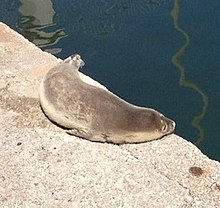Monachus monachus
| Mediterranean monk seal | |
|---|---|
 |
|
| Scientific classification | |
| Kingdom: | Animalia |
| Phylum: | Chordata |
| Clade: | Synapsida |
| Class: | Mammalia |
| Order: | Carnivora |
| Suborder: | Caniformia |
| Clade: | Pinnipedia |
| Family: | Phocidae |
| Genus: |
Monachus Fleming, 1822 |
| Species: | M. monachus |
| Binomial name | |
|
Monachus monachus (Hermann, 1779) |
|
 |
|
| Mediterranean monk seal range | |
The Mediterranean monk seal (Monachus monachus) is a monk seal belonging to the family Phocidae. As of 2016[update], it is estimated that fewer than 700 individuals survive in three or four isolated subpopulations in the Mediterranean (especially in the Aegean Sea), the archipelago of Madeira and the Cabo Blanco area in the northeastern Atlantic Ocean. It is believed to be the world's rarest pinniped species.
This species of seal grows from approximately 80 centimetres (2.6 ft) long at birth up to an average of 2.4 metres (7.9 ft) as adults. Males weigh an average of 320 kilograms (710 lb) and females weigh 300 kilograms (660 lb), with overall weight ranging from 240–400 kilograms (530–880 lb). They are thought to live up to 45 years old; the average life span is thought to be 20 to 25 years old and reproductive maturity is reached at around age four.
The monk seals' pups are about 1 metre (3.3 ft) long and weigh around 15–18 kilograms (33–40 lb), their skin being covered by 1–1.5 centimeter-long, dark brown to black hair. On their bellies, there is a white stripe, which differs in color and shape between the two sexes. In females the stripe is usually rectangular in shape whereas in males it is usually butterfly shaped. This hair is replaced after six to eight weeks by the usual short hair adults carry.
Pregnant Mediterranean monk seals typically use inaccessible undersea caves while giving birth, though historical descriptions show they used open beaches until the 18th century. There are eight pairs of teeth in both jaws.
Believed to have the shortest hair of any pinniped, the Mediterranean monk seal fur is black (males) or brown to dark grey (females), with a paler belly, which is close to white in males. The snout is short broad and flat, with very pronounced, long nostrils that face upward, unlike their Hawaiian relative, which tend to have more forward nostrils. The flippers are relatively short, with small slender claws. Monk seals have two pairs of retractable abdominal teats, unlike most other pinnipeds.
Very little is known of this seal's reproduction. Scientists have suggested that they are polygynous, with males being very territorial where they mate with females. Although there is no breeding season since births take place year round, there is a peak in October and November. This is also the time when caves are prone to wash out due to high surf or storm surge, which causes high mortality rates among monk seal pups, especially at the key Cabo Blanco colony. According to the IUCN species factsheet, "pup survival is low; just under 50% survive their first two months to the onset of their moult, and most mortalities occurred in the first two weeks. Survival of pups born from September to January is 29%. This very low survival rate is associated with mortality caused by severe storms, and high swells and tides, but impoverished genetic variability and inbreeding may also be involved. Pups born during the rest of the year had a survival rate of 71%".
...
Wikipedia

